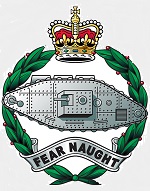Hobby Master HG3410 British M10 Tank Destroyer - 3rd Infantry Division, Normandy, 1944 (1:72 Scale)
"Seek, strike and destroy."
- Motto of the Tank Destroyer Command during World War II
 The M10 were, numerically, the most important US tank destroyer of World War II. In its combat debut in the North African campaign, the M10 was successful as its M7 3-inch gun could penetrate most German tanks then in service at long range. The heavy chassis did not conform to the tank destroyer doctrine of employing very light, high-speed vehicles, thus it began to be supplemented by the 76 mm Gun Motor Carriage M18 early in 1944. Later in the Battle of Normandy the M10's gun proved to be ineffective against the frontal armor of the numerous German Panther tanks encountered and by the fall of 1944 the improved 90 mm Gun Motor Carriage M36 was beginning to replace it, though it remained in service until the end of the war. In the Pacific, US Army M10s were used for traditional infantry-support missions and were unpopular due to their open topped turrets. The Japanese tactic of very close-in infantry attacks against US AFVs made the M10 much more vulnerable than a fully-enclosed tank.
The M10 were, numerically, the most important US tank destroyer of World War II. In its combat debut in the North African campaign, the M10 was successful as its M7 3-inch gun could penetrate most German tanks then in service at long range. The heavy chassis did not conform to the tank destroyer doctrine of employing very light, high-speed vehicles, thus it began to be supplemented by the 76 mm Gun Motor Carriage M18 early in 1944. Later in the Battle of Normandy the M10's gun proved to be ineffective against the frontal armor of the numerous German Panther tanks encountered and by the fall of 1944 the improved 90 mm Gun Motor Carriage M36 was beginning to replace it, though it remained in service until the end of the war. In the Pacific, US Army M10s were used for traditional infantry-support missions and were unpopular due to their open topped turrets. The Japanese tactic of very close-in infantry attacks against US AFVs made the M10 much more vulnerable than a fully-enclosed tank.
Approximately 54 M10s were supplied to the USSR though their usage in Red Army service is largely unrecorded. The M10 also equipped units of the Free French Army; one M10 named "Sirocco", crewed by a regiment composed of French sailors, famously knocked out a German Panther tank on the Place de la Concorde in Paris. British M10s were designated 3 in SP, Wolverine and saw action in Italy and France, including some re-armed with the much more effective 17-pounder guns which gained the designation 17 pdr SP. Achilles.
The M10 had an open-topped turret that left it vulnerable to artillery and mortar fire and infantry assault especially in urban combat and forest areas, where a simple hand grenade could be tossed inside. By the end of the war its armor was too thin to provide protection from the new German tanks and anti-tank guns. The other main disadvantage of the M10 was its very slow turret traverse, the M10 did not have powered traverse and so the crew had to hand-crank the turret to traverse it, taking approximately two minutes to traverse 360 degrees. US tank destroyers fired much more HE than anti-tank ammunition, indicating that they were employed much like the tanks they were supposed to support.
This particular 1:72 scale replica of a M10 tank destroyer was attached to the British 3rd Infantry Division, then serving in Normandy during 1944.
Sold Out!
Dimensions:
Length: 4-inches
Width: 1-1/2-inches
Release Date: June 2010
 Historical Account: "The Iron Division" - The 3rd Infantry Division, known at various times as the Iron Division, 3rd (Iron) Division or as Iron Sides; is a regular army division of the British Army. It was created in 1809 by Arthur Wellesley, 1st Duke of Wellington for service in the Peninsular War, and was known as the Fighting 3rd under Sir Thomas Picton during the Napoleonic Wars. The division is also sometimes referred to as the Iron Division, a nickname earned during the bitter fighting of 1916, during the First World War. The division's other battle honours include: the Battle of Waterloo, the Crimean War, the Second Boer War, the Battle of France (1940) and D-Day (1944). It was commanded for a time, during the Second World War, by Bernard Montgomery. The division was to have been part of a proposed Commonwealth Corps, formed for a planned invasion of Japan in 1945-46, but was disbanded when the war was ended by the bombing of Hiroshima and Nagasaki.
Historical Account: "The Iron Division" - The 3rd Infantry Division, known at various times as the Iron Division, 3rd (Iron) Division or as Iron Sides; is a regular army division of the British Army. It was created in 1809 by Arthur Wellesley, 1st Duke of Wellington for service in the Peninsular War, and was known as the Fighting 3rd under Sir Thomas Picton during the Napoleonic Wars. The division is also sometimes referred to as the Iron Division, a nickname earned during the bitter fighting of 1916, during the First World War. The division's other battle honours include: the Battle of Waterloo, the Crimean War, the Second Boer War, the Battle of France (1940) and D-Day (1944). It was commanded for a time, during the Second World War, by Bernard Montgomery. The division was to have been part of a proposed Commonwealth Corps, formed for a planned invasion of Japan in 1945-46, but was disbanded when the war was ended by the bombing of Hiroshima and Nagasaki.
During the Second World War, the insignia became the "pattern of three" - a black triangle trisected by an inverted red triangle.







![US Navy Northrop F-5E Tiger II Fighter - 527th Aggressor Squadron, Alconbury AB, England, 1976-1988 [Aggressor Scheme] (1:72 Scale)](http://cdn4.volusion.store/qh9e9-jdqv9/v/vspfiles/photos/HA3336-1.jpg?v-cache=1740197136)

